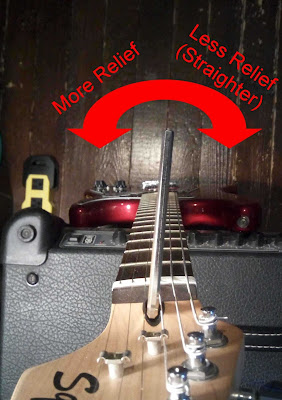A basic setup has four steps, which should be performed in order. I'm going to dedicate a separate post to each step.
- Adjust the truss rod (this post)
- Set the string height
- Set the pickup height
- Adjust the intonation
Adjusting the truss rod:
Contrary to what some people think, the truss rod is not something you turn to make the strings higher or lower. Rather, its purpose is to adjust the straightness of the guitar neck. The pull exerted by the strings bend the neck, as a general rule, in the same way that a bow and arrow bend when the bowstring is pulled. The truss rod controls how much relief (bend) the neck has. Turning it to the right will straighten the neck, and turning it to the left will allow more relief. See the image below.
Ideally, you want the neck either straight or with a bit of controlled relief. The best way to evaluate neck straightness/relief is to use a notched straightedge. It'll give you an accurate reading all the way up the neck from the fretboard, rather than the tops of the frets. A regular straightedge will also work, though it can sometimes be slightly less accurate (I've used a quilting square ruler with success on several occasions).
Another method, that doesn't require any tools, is to press down the low E string at the 1st and 22nd frets and check the gap between the top of the 8th fret and the bottom of the string.
When turning the truss rod, it's important to take it slow. Don't go cranking away at it. Make adjustments a little bit at a time, and give them some time to settle in. Be gentle when you apply pressure, as well; a broken truss rod is an involved repair.
The exact amount of relief that's best is something that varies from player to player, and you'll find what works best for you by experimenting. A rule of thumb that I like to use is that the factory specs typically recommend a gap about the size of the diameter of the high E string. That's a good place to start from. A flatter neck will let you get lower, faster action. On the other hand, if you play with hard attack and like to strum aggressively, you might need to give the neck some relief to keep the strings from rattling and buzzing badly.
So that's the first step for setting up your guitar. Once you've adjusted the neck relief to where it seems good, you can move on to setting the string height, which will be my next post.


Comments
Post a Comment